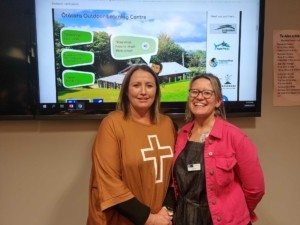
Incorporating outdoor learning into everyday education was the focus of a policy think-tank held at EIT’s Hawke’s Bay Campus recently.
Hosted by the EIT Research and Innovation Centre, about 20 educators attended a lively session titled, ‘Learning in Nature: How can we better support teachers to use the environment in teaching and learning’.
Emma Passey, Environment and Sustainability Manager, responsible for managing the Ōtātara Outdoor Learning Centre and promoting learning in nature throughout the region, spoke on the importance of normalising nature literacy and embedding it within the school curriculum.
Emma said that while there is support by educators to use nature in the context of learning, there are also some barriers – for example, the perception that it’s too hard to fit “something else” into the curriculum and busy timetables.
“It is about normalising nature literacy and making teachers feel like it is an everyday thing that they can do rather than it being some big thing that they must do, she said.
“It doesn’t have to be a big field trip that you take kids on. Instead, it is about how you can use your local environment and make it easily accessible.”
She says greater engagement with our environment by educators and learners supports lasting, positive connections such as increased pro-environmental behaviour and better health and wellbeing outcomes.
The regional Learning in Nature project and the Ōtātara Outdoor Learning Centre is a collaboration between several organisations including EIT, Ngāti Pārau, Hawke’s Bay Regional Council, Enviro-Schools and the Department of Conservation, who work together to support schools and community groups to use the environment in the context of learning.
Bledisloe School is one of the Centre’s early adopters. Deputy principal, Di Harris, says the Outdoor Learning Centre at EIT has become a place of wellbeing for their school where learners are able to connect within themselves, their people, and their environment.
She made reference to the four cornerstones of Te whare tapa whā.
“In te ao Māori, it is called ‘tau’ – the sense of just being centred and I think our kids need this in today’s day and age. And that for us has been a big driver.”
Mrs Harris believes their success comes down to the fact that they have just “used” the space that the Ōtātara Outdoor Learning Centre provides’.
“If we can convince teachers that this isn’t another thing, but it enriches something that you’re already doing, then people will use the centre and be able to see benefit from what they’re gaining by connecting with it.”
Currently, she says there is a real push around using the New Zealand curriculum but localising it to the context of a school community and location.
“Your local curriculum should be unique and responsive to the preferences and issues of your community and your people.”
Their school role is 40 per cent Māori students. “We want to connect our kids to this area where we have a strong link to Ngāti Pārau, the Waiohiki Marae and the Ōtatara Pā We feel very connected to this place, which is why the Ōtatara Outdoor Learning Centre is so valuable to us.”
EIT’s Executive Dean – Faculty of Education, Humanities and Health Science and Professor of One Welfare, Professor Nat Waran, says:
‘Its really exciting to see this Regional Learning in Nature educational space, being used by so many schools and community groups to enhance the lives of individuals by connecting them with nature, cultural heritage and sustainability values through landscape and the curriculum.’
